In this tutorial, we will be making a simple physics simulation in Unity with actions triggered by Deepgram's automatic speech recognition (ASR) engine. Why use Deepgram with Unity? Well, Unity is an industry standard when it comes to game development, and while speech-enhanced games have been around for decades, high performance, easy-to-use ASR is relatively new, and Deepgram represents the cream-of-the-crop. So if you are looking to try something new with your games, perhaps for a more immersive or accessible experience, I highly recommend trying this out!
This tutorial assumes no prior experience with Unity or C# (the language Unity uses for scripting). However, its focus is on getting you quickly set up to integrate Deepgram in your Unity project, and does not cover Unity game development or the C# language in depth. There are a plethora of resources out there to learn game development with Unity, and I highly recommend checking out their learning website as a starting point!
Finally, for an example of a simple game built with Deepgram ASR, you can check out Spooky Speech Spells.
Pre-requisites
You will need:
Unity installed on your machine - download Unity here. This tutorial was written with the Unity Editor version
2020.3.30f1.(Optional) VS Code or Script Inspector 3 for editing C# Unity scripts (you can use any text editor, but these are highly recommended for their Unity integration).
A Deepgram API Key - get an API Key here.
Try the Demo
To run the demo we are going to build and browse its files:
Download this repository, open Unity, click "Open", and browse to and select the directory
UnityDeepgramDemo.Edit the script
UnityDeepgramDemo/Assets/DeepgramInstance.csand replace the stringINSERT_YOUR_API_KEYwith your Deepgram API key.In the bottom left "Project" tab open
Assets -> Scenesand double click "SampleScene" to load this scene.In the top center of the Unity editor, hit the "Play" (►) button.
Say "left," "right," "up," and "down" to move the ball around!
Building the Demo
In the following sections, we will walk through step-by-step how to make this demo where you can move a ball around a simulated physics environment just by commanding it via your computer's microphone.
Setting Up the Project
Open Unity and click "New project".

You will be presented with a list of templates - choose "2D", and under the "Project Settings" panel name the project "UnityDeepgramDemo" (or whatever you'd like!) and choose a location for the project on your filesystem. Then click "Create project."

We are now in the Unity Editor. Our demo will rely on one external package to help us handle the websocket connection to Deepgram - Native WebSockets.
To install Native WebSockets, first, open the Package Manager from Window -> Package Manager.
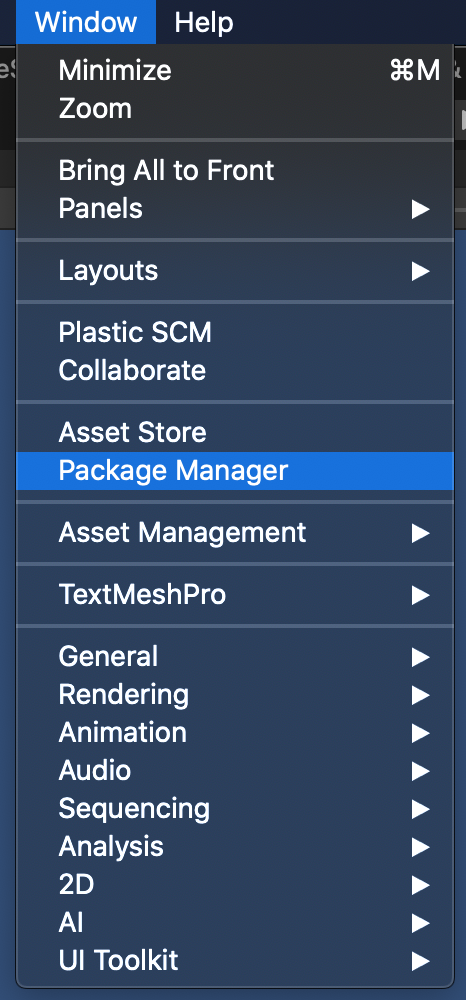
Then click the "+" drop-down and click "Add package from git URL...".

Enter the URL: https://github.com/endel/NativeWebSocket.git#upm and click "Add."
We are now ready to start putting the demo together!
Creating Physics Objects
In the center of the Unity Editor are the "Scene" and "Game" tabs. We will spend most of our time in the "Scene" tab, though when we play the game, we will be shifted over to the "Game" tab. On the left side of the Unity Editor is the "Hierarchy" tab - this is where we will be adding our game objects.
Let's add some physics objects to our scene - we are going to create a box out of 4 static (non-movable) walls, and add a dynamic (movable) ball in the center.
In the "Hierarchy" tab, right-click and select 2D Object -> Physics -> Static Sprite.
![]()
We now have a static square sprite in the center of our scene. Let's move this square to the left and make it a vertical rectangle to start building our box. To do this, go to the "Inspector" tab on the right. Under "Transform," change the "X" "Position" to -5 and the "Y" "Scale" to 5. This will stretch the square into a vertical rectangle 5 units tall, and place it 5 units to the left.
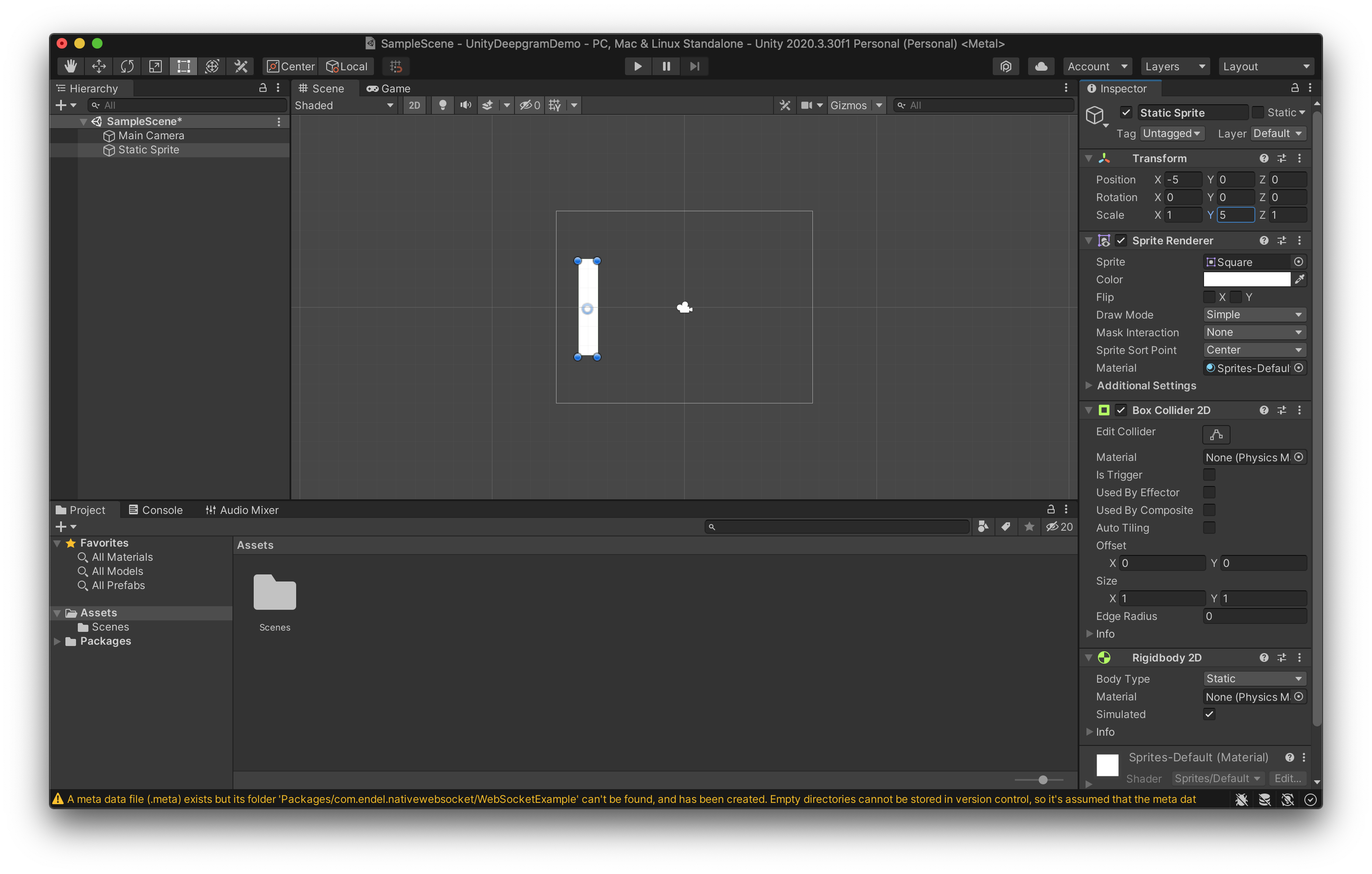
Now, right-click the "Static Sprite" object in the "Hierarchy" tab, click "Rename," and rename it "WallLeft." Let's do the same procedure to make a "WallRight," "WallUp," and "WallDown."
For "WallRight," change the "X" "Position" to 5 and the "Y" "Scale" to 5. For "WallUp," change the "Y" "Position" to 3 and the "X" "Scale" to 9. And for the "WallDown," change the "Y" "Position" to -3 and the "X" "Scale" to 9. You should now have a box which looks like this:
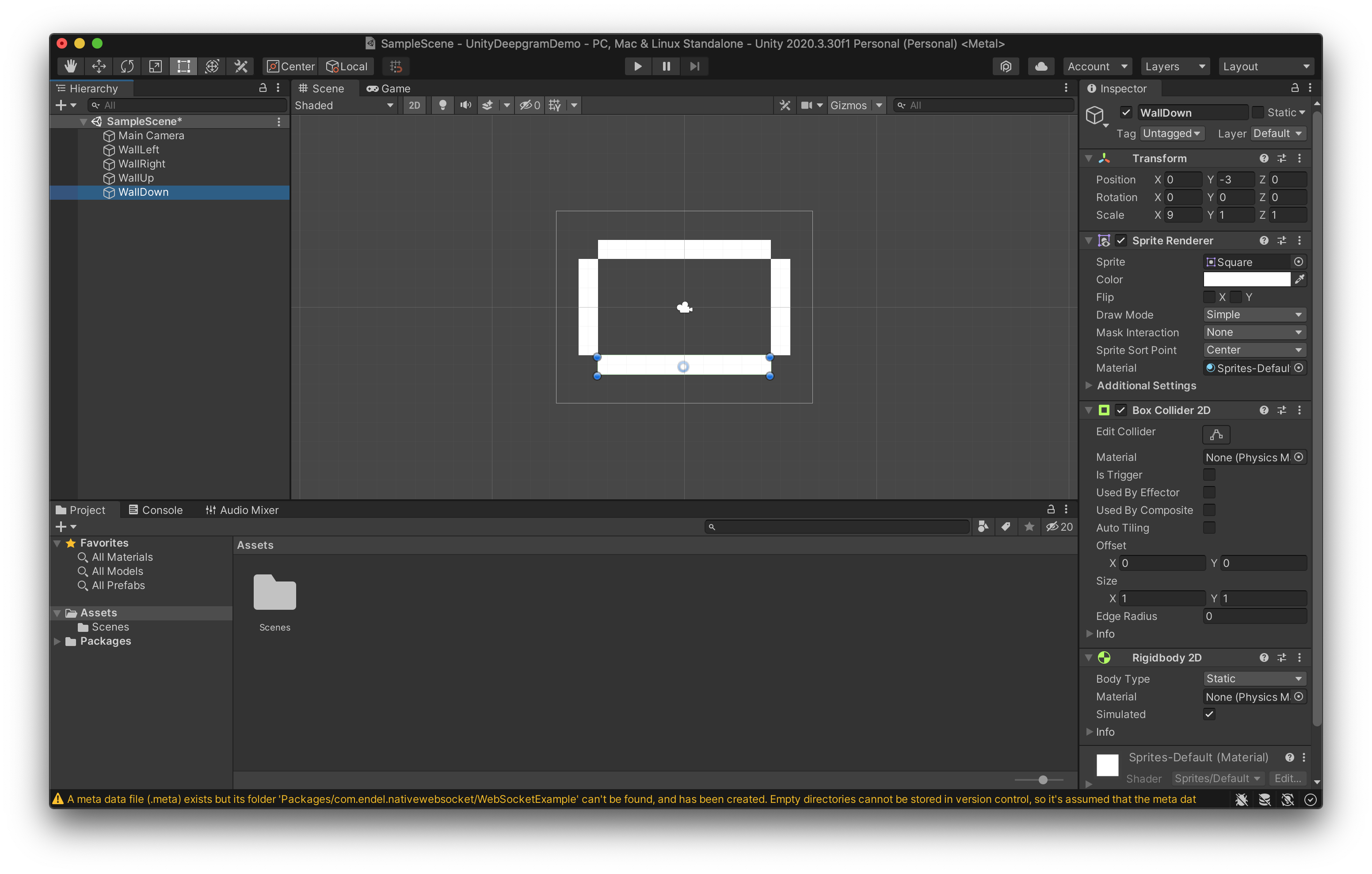
Let's add a dynamic ball inside the box. Right-click inside the "Hierarchy" tab and select 2D Object -> Physics -> Dynamic Sprite and name the object "Ball."
Dynamic sprites have gravity applied to them by default, and this can be changed if desired in the "Gravity Scale" field of the "Rigidbody 2D" node in the "Inspector" tab.
For now, let's leave it at the default value. Feel free to press "Play" (►) to start the game! You should see the ball fall to the bottom of the box - not much going on yet.
(Note, however, that you will not be able to do certain edits on the game until you stop playing the game by pressing again on the "Play" (►) button.)
Finally, let's attach a script to our "Ball" object. In the bottom panel, select the "Project" tab and open the "Assets" directory. Right-click in the "Assets"
panel and select Create -> C# Script. Name the script Ball (on your OS's filesystem, the file will exist as Ball.cs). Open this script with your text
editor of choice, and paste the following contents:
using System.Collections;
using System.Collections.Generic;
using UnityEngine;
public class Ball : MonoBehaviour
{
public int forceFactor = 300;
void Start()
{
}
void Update()
{
}
public void PushLeft()
{
Rigidbody2D rigidBody = GetComponent<Rigidbody2D>();
rigidBody.AddForce(Vector2.left * forceFactor);
}
public void PushRight()
{
Rigidbody2D rigidBody = GetComponent<Rigidbody2D>();
rigidBody.AddForce(Vector2.right * forceFactor);
}
public void PushUp()
{
Rigidbody2D rigidBody = GetComponent<Rigidbody2D>();
rigidBody.AddForce(Vector2.up * forceFactor);
}
public void PushDown()
{
Rigidbody2D rigidBody = GetComponent<Rigidbody2D>();
rigidBody.AddForce(Vector2.down * forceFactor);
}
}This script defines the class Ball, which inherits from Unity's MonoBehavior class. The class has one member variable, forceFactor, and defines
4 methods that can be used to move the object, PushLeft, PushRight, PushUp, and PushDown. We will not use these methods yet, but when we
implement our Deepgram integration, we will trigger these methods when you say the words "left," "right," "up," and "down."
So now we have a "Ball" script and a "Ball" object, but they are not coupled yet! To attach the script to the object, click the object in the "Hierarchy" tab, and drag the "Ball" script to the "Add Component" button found at the bottom of the "Inspector" tab.
Implementing the Deepgram Integration
To implement the Deepgram integration, we will need to create an object which handles microphone input and an object which handles the websocket connection to Deepgram.
Let's start with the websocket handler. Right-click in the "Hierarchy" tab and select "Create Empty" - name this object "DeepgramObject." Now, create a new script and name it "DeepgramInstance." Edit the script and add the following contents:
using System;
using System.Collections;
using System.Collections.Generic;
using UnityEngine;
using UnityEditor;
using System.Text.RegularExpressions;
using NativeWebSocket;
[System.Serializable]
public class DeepgramResponse
{
public int[] channel_index;
public bool is_final;
public Channel channel;
}
[System.Serializable]
public class Channel
{
public Alternative[] alternatives;
}
[System.Serializable]
public class Alternative
{
public string transcript;
}
public class DeepgramInstance : MonoBehaviour
{
WebSocket websocket;
public Ball _ball;
async void Start()
{
var headers = new Dictionary<string, string>
{
{ "Authorization", "Token INSERT_YOUR_API_KEY" }
};
websocket = new WebSocket("wss://api.deepgram.com/v1/listen?encoding=linear16&sample_rate=" + AudioSettings.outputSampleRate.ToString(), headers);
websocket.OnOpen += () =>
{
Debug.Log("Connected to Deepgram!");
};
websocket.OnError += (e) =>
{
Debug.Log("Error: " + e);
};
websocket.OnClose += (e) =>
{
Debug.Log("Connection closed!");
};
websocket.OnMessage += (bytes) =>
{
var message = System.Text.Encoding.UTF8.GetString(bytes);
Debug.Log("OnMessage: " + message);
DeepgramResponse deepgramResponse = new DeepgramResponse();
object boxedDeepgramResponse = deepgramResponse;
EditorJsonUtility.FromJsonOverwrite(message, boxedDeepgramResponse);
deepgramResponse = (DeepgramResponse) boxedDeepgramResponse;
if (deepgramResponse.is_final)
{
var transcript = deepgramResponse.channel.alternatives[0].transcript;
Debug.Log(transcript);
int leftCount = new Regex(Regex.Escape("left")).Matches(transcript).Count;
int rightCount = new Regex(Regex.Escape("right")).Matches(transcript).Count;
int upCount = new Regex(Regex.Escape("up")).Matches(transcript).Count;
int downCount = new Regex(Regex.Escape("down")).Matches(transcript).Count;
for (int i = 0; i < leftCount; i++)
{
_ball.PushLeft();
}
for (int i = 0; i < rightCount; i++)
{
_ball.PushRight();
}
for (int i = 0; i < upCount; i++)
{
_ball.PushUp();
}
for (int i = 0; i < downCount; i++)
{
_ball.PushDown();
}
}
};
await websocket.Connect();
}
void Update()
{
#if !UNITY_WEBGL || UNITY_EDITOR
websocket.DispatchMessageQueue();
#endif
}
private async void OnApplicationQuit()
{
await websocket.Close();
}
public async void ProcessAudio(byte[] audio)
{
if (websocket.State == WebSocketState.Open)
{
await websocket.Send(audio);
}
}
}Insert your Deepgram API key where the script says "INSERT_YOUR_API_KEY," then attach this script to the "DeepgramObject", and in the "Inspector" tab click the "Ball" field and select the "Ball" object we created earlier.
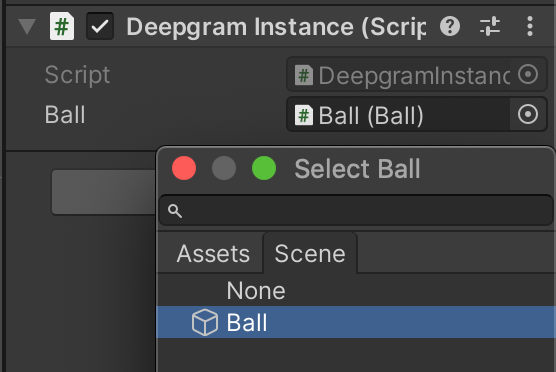
Ok, so what's going on here? Well, first the script defines the classes DeepgramResponse, Channel, and Alternative which we will use to deserialize
the Deepgram ASR response, which is in JSON format. Then the script defines the class DeepgramInstace which has two member variables: a WebSocket object,
defined by NativeWebSocket, and a Ball object, defined by us in the "Ball" script.
When the object that this script is attached to gets created, the Start method gets called. Inside Start, we create a new websocket connection to Deepgram
and define functions that need to get executed when that connection opens, closes, receives an error, and receives a message. When the websocket connection
receives a message, we first parse it as a string, and then use EditorJsonUtility to parse the string as a JSON object, deserializing it as a DeepgramResponse
object. We can then directly access the transcript contained in this Deepgram message, count how many times the words "left," "right," "up," and "down" were spoken,
and for each time these words were spoken, we call the PushLeft, PushRight, PushUp, and PushDown methods on our Ball object!
Near the end of the script is one more method of note: ProcessAudio. This method will be called by our microphone object, which will pass in raw audio. ProcessAudio
will then check to see if the websocket connection is open, and if it is, pass the audio along to Deepgram.
Now let's create an object to handle the microphone input. Right-click in the "Hierarchy" tab, select Audio -> AudioSource, and name this object "MicrophoneObject."
Then create a new script called "MicrophoneInstance" and make its contents the following:
using System.Collections;
using System.Collections.Generic;
using UnityEngine;
using UnityEngine.Audio;
[RequireComponent (typeof (AudioSource))]
public class MicrophoneInstance : MonoBehaviour
{
AudioSource _audioSource;
int lastPosition, currentPosition;
public DeepgramInstance _deepgramInstance;
void Start()
{
_audioSource = GetComponent<AudioSource> ();
if (Microphone.devices.Length > 0)
{
_audioSource.clip = Microphone.Start(null, true, 10, AudioSettings.outputSampleRate);
}
else
{
Debug.Log("This will crash!");
}
_audioSource.Play();
}
void Update()
{
if ((currentPosition = Microphone.GetPosition(null)) > 0)
{
if (lastPosition > currentPosition)
lastPosition = 0;
if (currentPosition - lastPosition > 0)
{
float[] samples = new float[(currentPosition - lastPosition) * _audioSource.clip.channels];
_audioSource.clip.GetData(samples, lastPosition);
short[] samplesAsShorts = new short[(currentPosition - lastPosition) * _audioSource.clip.channels];
for (int i = 0; i < samples.Length; i++)
{
samplesAsShorts[i] = f32_to_i16(samples[i]);
}
var samplesAsBytes = new byte[samplesAsShorts.Length * 2];
System.Buffer.BlockCopy(samplesAsShorts, 0, samplesAsBytes, 0, samplesAsBytes.Length);
_deepgramInstance.ProcessAudio(samplesAsBytes);
if (!GetComponent<AudioSource>().isPlaying)
GetComponent<AudioSource>().Play();
lastPosition = currentPosition;
}
}
}
short f32_to_i16(float sample)
{
sample = sample * 32768;
if (sample > 32767)
{
return 32767;
}
if (sample < -32768)
{
return -32768;
}
return (short) sample;
}
}Attach this script to the "MicrophoneObject", and in the "Inspector" tab click the "DeepgramInstance" field and select the "DeepgramObject" object we created earlier.
In this script, we define the MicrophoneInstance class which contains an AudioSource member variable, a DeepgramInstance member variable, and 2 integer member
variables which help to keep track of where we are in the microphone's audio stream. The Start method will set up the microphone to stream audio data into
the clip of the AudioSource object, and will start playback of the AudioSource.
The Update method of a MonoBehavior class gets called by the under-the-hood game loop every frame and is the typical place to handle game logic.
In our case, it gets the current position of the microphone's audio stream, compares it to the last position of the microphone's audio stream to
create a buffer, samples, of floats the right size to store all of the new audio data since the last time Update was called, grabs that audio data via the method GetData
and stores it in samples. Then, these f32 samples are converted to i16 samples, and then converted to raw bytes, and finally passed to the DeepgramInstance's ProcessAudio
method which, as we mentioned before, will then pass that audio on to Deepgram to get transcribed!
Now, we are almost ready to try out our demo. There is one more task to do to make the demo reasonably playable, and if you try to play the demo now, you may see what it is!
Currently, in order to get the microphone's audio data, the microphone's audio stream must play. However, having the microphone's audio play through your computer's speakers
can be problematic and lead to feedback issues (plus, hearing your voice in the game isn't the point). To fix this issue, go to the "Assets" panel, right-click,
and select Create -> Audio Mixer. Name the mixer "Mixer."
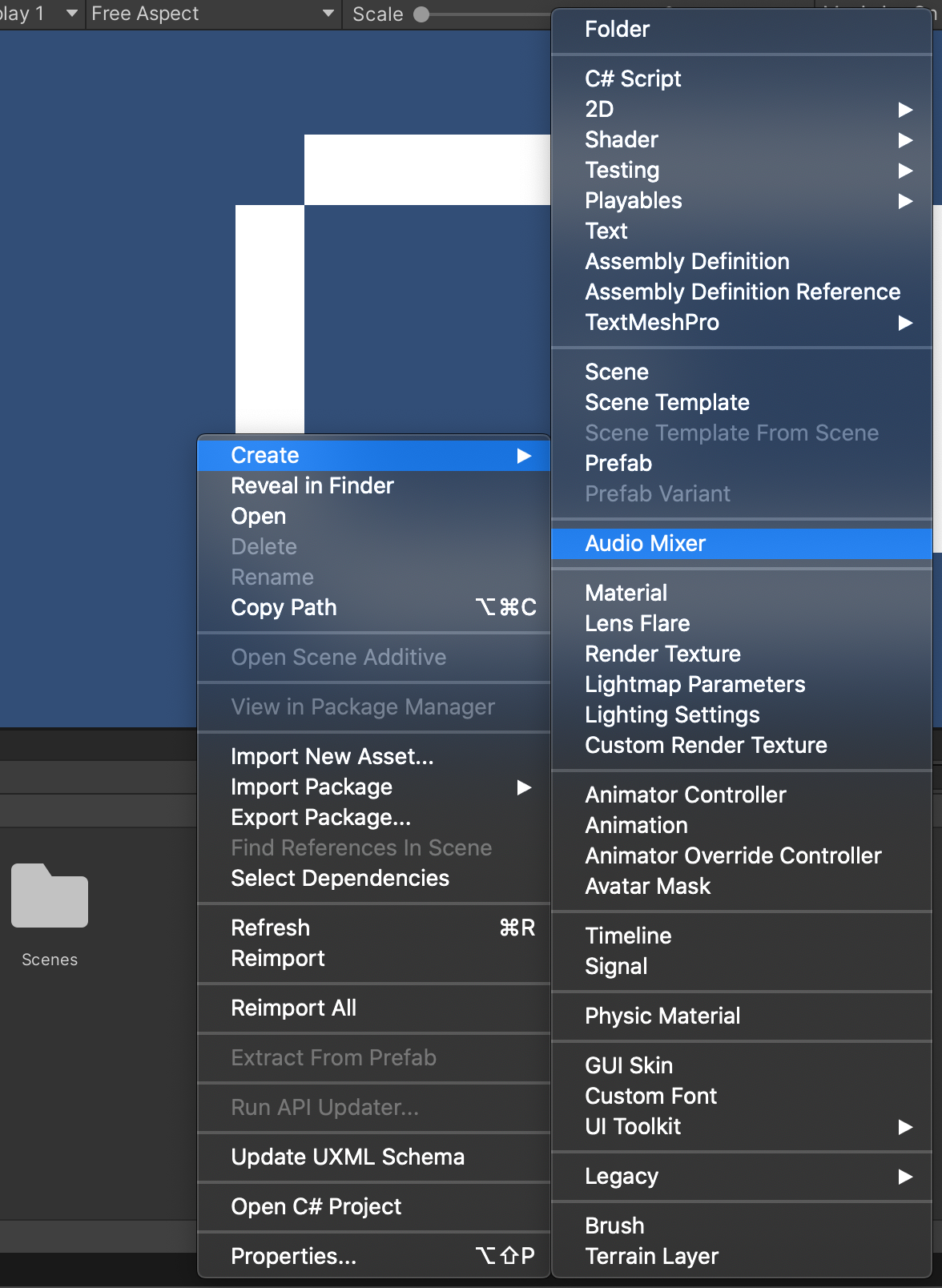
Double click "Mixer" in the "Assets" panel, then next to "Groups" click the "+" button and name the group "Microphone." Now go to the fader for this group and turn it all the way down.
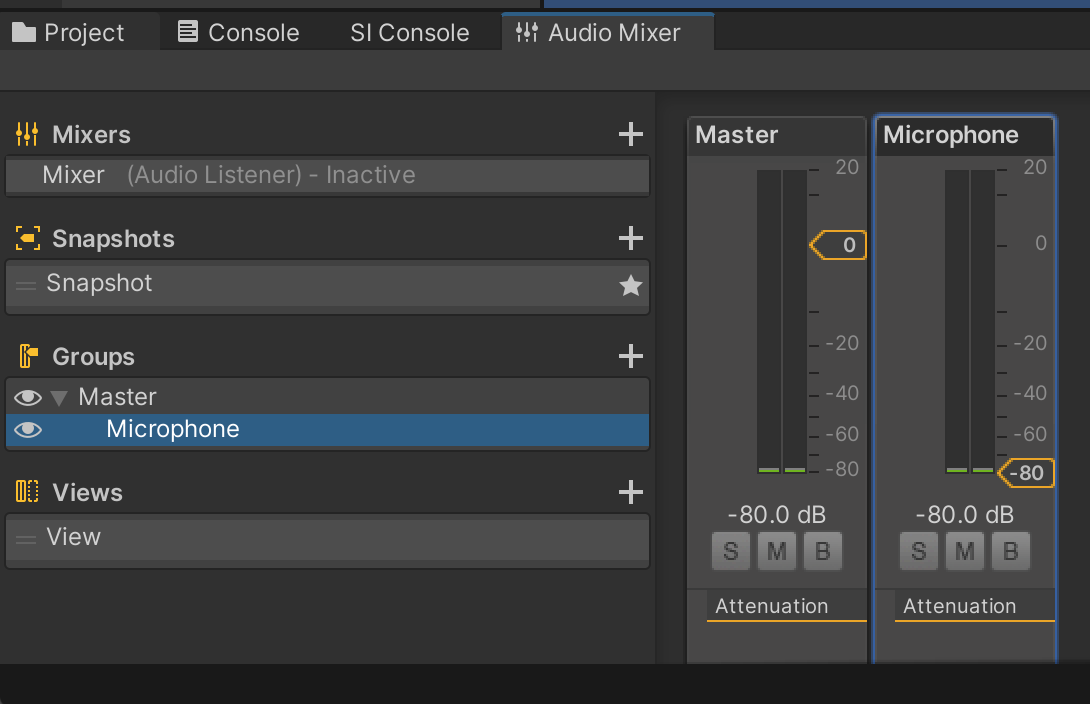
Now, click the "MicrophoneObject" in the "Hierarchy" tab and then click on the field for "Output" in the "Audio Source" node in the "Inspector" tab and select "Microphone (Mixer)." This will ensure the microphone audio can stream its data without being directed to your speakers!
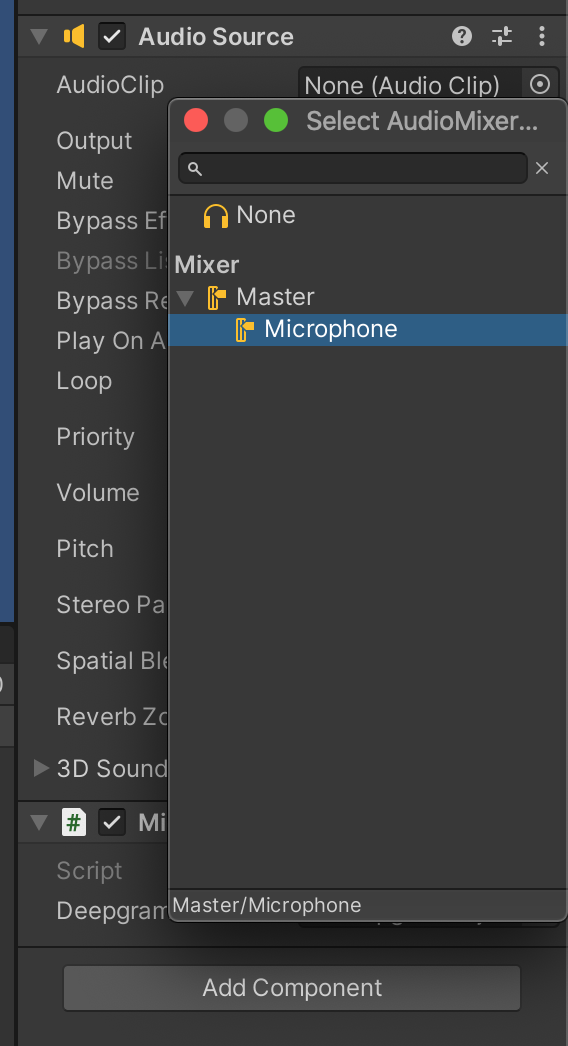
You should now be able to press "Play" (►) and make the ball jump around by saying "left," "right," "up," or "down" in the microphone!
Build New Features
Controlling a single ball with commands has a noticeable amount of latency. This can be alleviated somewhat by using interim results, however, the same transcribed word might be present in subsequent interim results, so logic would have to be added to avoid double counting commands. Still, the use of interim results can vastly reduce latency, so I strongly suggest trying it out! In addition, here are a few more things to think about and try out with this demo before diving into a full-on speech-enhanced game:
Change the Physics Material of the ball to make it bounce instead of stick to walls.
Add more balls to the box - try making just one of them, several of them, or all of them react to the speech commands.
Give the balls different colors, and implement logic to control each group (like "red, left!", "blue, up!").
Remove gravity for balls and exchange the simple box with a sprawling level of walls.
If you try out the above ideas, you may come to a fun idea for a game - how about a game along the lines of Pikmin, where you command different groups of creatures to move to different parts of the map to accomplish objectives? Instead of using a complex user interface of buttons, mice, and/or a keyboard, the game could simply require you to dictate commands!
Final Thoughts
Speech-enhanced games are not necessarily new, but until recently they have mostly centered around a handful of command words. With today's ASR engines like Deepgram, supporting thousands of command words out of the box has become trivial, indeed transcribing entire conversations and complex commands is now easily within reach and has the power to enrich games. I'll end with a few ideas which may give you some inspiration!
Along the lines of the example mentioned in the previous section, build an RTS where you control units with your voice. There may be more latency than you get with a mouse click, but this could be turned into a core game mechanic - maybe you are communicating with your units via a radio, and any network + transcription latency would feel like latency of your units receiving your message.
Also following up on this idea, make a game where you primarily control a single player, but have the option to give commands to other AI players on your team - these commands could be conveyed with your voice without having to swap to a complex menu, interrupting the control of your primary character. (For a concrete example, think Hyrule Warriors.)
For MOBAs where voice chat is not easily available (think Pokémon Unite), allow for command phrases to be selected via ASR instead of clunky menus.
To avoid issues with latency entirely, make speech-enhanced sections of your game occur during context-sensitive situations where the main action of the game pauses so that reaction time becomes a non-issue. As an example, in many Zelda games, the game freezes when you pull out an instrument, and playing the right notes on the instrument can cause events to occur - imagine this but with ASR and specific phrases.
For in-game voice chat, write a plugin that performs ASR for each player in their preferred language (see Deepgram's supported languages here, and then passes the resulting transcripts through a translator to display everyone's speech to everyone else in their preferred language.
Speech-in-games is a relatively untapped area, so this list of ideas and suggestions is far from exhaustive, but I sincerely hope this helps on the journey towards making games more immersive, interesting, and inclusive!
If you have any questions, please feel free to reach out on Twitter - we're []DeepgramAI](https://twitter.com/DeepgramAI).
If you have any feedback about this post, or anything else around Deepgram, we'd love to hear from you. Please let us know in our GitHub discussions .
More with these tags:
Share your feedback
Was this article useful or interesting to you?
Thank you!
We appreciate your response.





